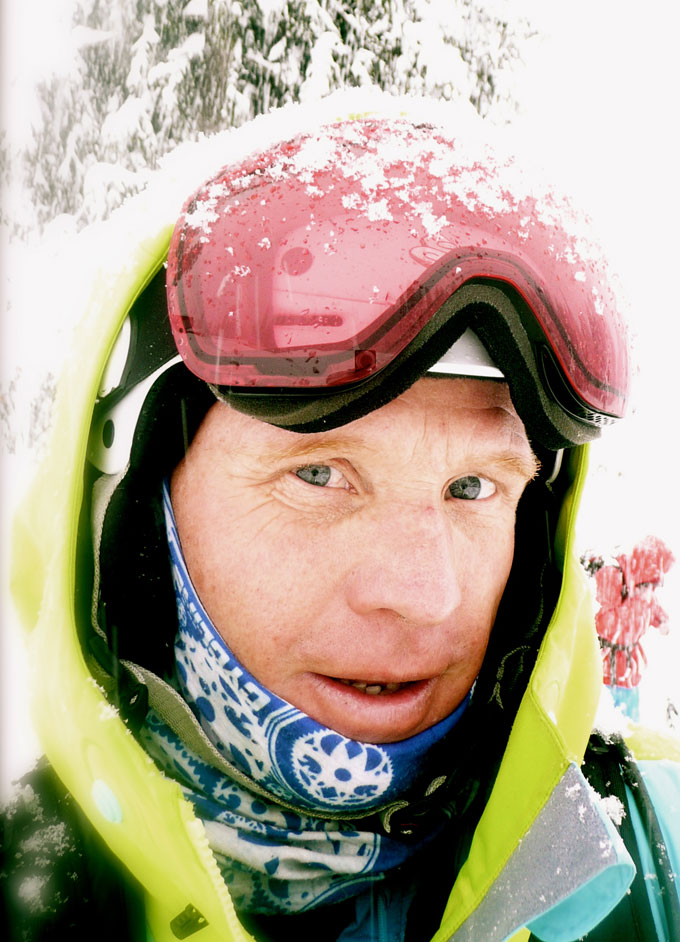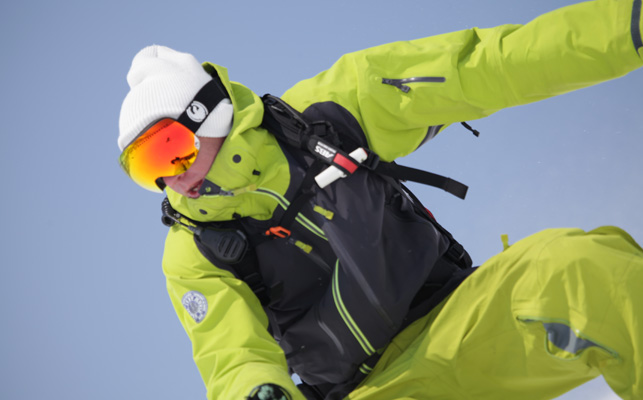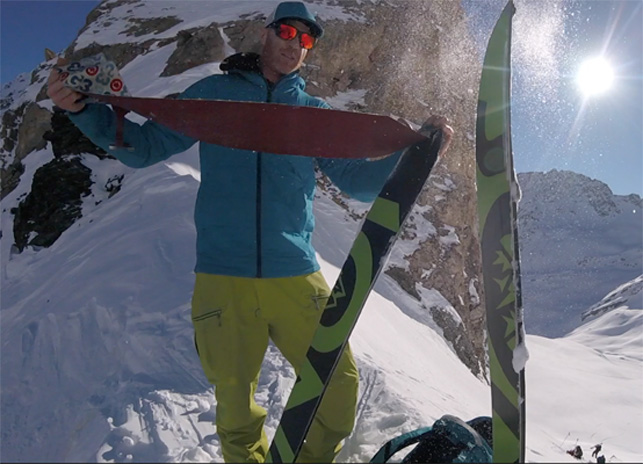
Avalanche Airbags compared and the Jones Flagship vs carbon Flagship
Its gone from being super mild to winter in one day here in Chamonix and now we have loads of snow and freezing temps.
As stated in the forecast the temperatures are Glacial (french) or Bitterly cold (english) and getting colder!
The wind is form the North at the moment which is why it is so cold.
Very strong wind up high, a windslab making machine up there no doubt!
The avalanche risk was on a factor 4 to 5 above 2300m for a while but has dropped to a 3 for the moment.
Interesting to note that it is a 3 on all aspects at all altitudes due to wind loading and no temperature effect.
A Guiding friend of mine noted whumping/settling of slopes in the lower altitudes, whilst over in Italy, which did trigger a slab release at a higher altitude, so a large propogation in the snowpack, which is exactly what I predicted would happen after touring in Tignes a week or so ago and experiencing the slopes settling, but obviously then with out risk as it was before this latest snowfall.
Anyway, I’ve had a few questions on equipment recently so thought I’d post a bit of the info that I replied with just in case it is of any use to anyone else…
The first question was on Removable Airbag Systems created by Ortovox, so here’s some info on Airbags in general.
Basically at the moment you have 2 tried and tested systems for Avalanche Airbag Backpacks, the ABS (Air Bag System) and the Snowpulse.
(Blackdiamond have also recently developed their own fan assisted Airbag system but as yet I have not seen, tried or tested this system).
Both ABS and Snowpulse pretty much do the same job in the same manner, a trigger releases gas or air from a pressurised canister which is used to inflate a large Airbag that breaks out of the pack to increase your volume and so help you float on the top of an avalanche and help you avoid a burial.
my ABS pack with a zip on volume by Millet
ABS!
ABS use a twin Airbag system, 2 airbags are released from velcro closed pockets on either side of the pack. The trigger is a simple handle pull mechanism that uses an small explosive charge to pierce the canister to release the pressurised gas and fill the airbags.
ABS created this unit in a stand alone BASE pack onto which you can zip different volume back packs to suit different adventures. The contents of the BASE pack are thus independent of the contents of the volume and so a fully packed zip on volume should not in anyway interfere with the deployment of the airbag system.
To me the changeable volume system is a plus point for this system as I can zip on a lightweight 18L volume for Off piste excursions and then switch it to a 30L+ volume for bigger days. I think the biggest zip on Volume I have is around 38/40L which is a good size for multi day touring.
Many leading winter Sports brands now make zip on volumes in various sizes that are compatible with the ABS system and some of them are well designed and snowboarder friendly such as the Evoc 30L guide pack which has side compression strap and the millet safeguard 28+7L which has a very useful pullout helmet pocket.
On a slightly negative point, once the system has been deployed it cannot be re used and the handle and canister must be replaced. The BASE pack is itself quite heavy and transporting the pack overseas can cause some stress as it’s not always easy to take an explosive charge and pressurised canister on an aircraft these days. A printable flight friendly certificate can be printed off from the ABS website but in far off countries this document is not always self explanatory.
the ABS carbon canister.
Back to a positive note. spare canisters and handles can be bought separately and for those looking to reduce the weight of the system a Carbon Canister, which is more expensive, but is in my opinion, well worth the extra cost as it does significantly reduce the over all weight and feel of the BASE pack.
Another plus point to the ABS system is that the twin airbags are both independent and so if one is to not inflate, deflate or get punctured for any reason the other bag is not dependent on it to sustained inflation.
check out the ABS collection here.
Snowpulse!
Snowpulse developed a rival system to the ABS again using a pressurised canister that inflates, this time, a single Airbag. The original Snowpulse packs have the Airbag system stowed in the shoulder straps and behind the neck. On release the single airbag inflates from both shoulder straps and around the back of the head in what is called their ‘head on top technology’.
This system is designed to protect the head and neck of the victim and this can only be seen as a plus point to the system.
On a slightly negative point, the system releases through a breakable zip which can be done up again after deployment, but does create a slight weakness in a heavily loaded pack and in my experience is known to come undone at the velcro protected release point, from time to time, especially if the pack is fully loaded.
The Snowpulse system doesn’t use an explosive charge to pierce the canister, but uses a mechanical deployment that releases the gas. the Canister can be refilled and the handle re used and a depressurised canister poses no flight restrictions. Finding somewhere to re fill the canister might be more of a problem as the suggestion of using a diving shop is not always very practicable solution in a mountain scenario. Most people I know fly with the canister fully loaded and again a flight friendly certificate can be printed to aid with transportation.
Snowpulse packs, using this non removable system , the LIFEBAG system, come in pre designated volumes which can’t be interchanged. As such in order to have different size packs for different activites more than one complete system pack must be owned.
check out Snowpulse here
The RAS system
To get around this problem Snowpulse invented the RAS system or the Remouvable Airbag System. This is a single Airbag system that comes as a stand alone unit, airbag, canister and cable release handle which can be strapped into a RAS compatible pack and so can be moved from pack to pack.
Since its development, many leading Winter Sports brands have developed RAS compatible packs in many different volumes.
Jeremy Jones has designed a nice RAS compatible snowboard orientated pack at 30L. This is the best RAS snowboard pack you’ll find for sure. I’ve been using this pack with out the RAS system (as I simply don’t have one!) but check it out here
The RAS system uses a single pillow shaped airbag that inflates behind the victims head by breaking through a releasable zip system that I have unfortunately seen release on certain packs under heavy loading or in the event of a fall.
This zip is easily re done up, but on certain models the RAS system does not go into a separate compartment from the rest of the packs contents and so if the Zip breaks open under load it is possible that the packs contents are able to fall out.
Also I have concerns as to the ability of the airbag to release in the correct fashion if the backpack is loaded to the max and so compressing the system.
Recently Snowpulse became a partner of Mammut who are well known for making quality mountain safety products and so I am sure tests have been done for this eventuality but for me it would be an obvious concern and something to look at when choosing a model of RAS compatible pack.
MASS system.
To rival the RAS system, Ortovox, a leading Mountain safety brand and developer of Avalanche advanced safety kit such as the Ortovox 3+ transceiver worked with ABS in developing their own removable airbag system for their celebrated Ortovox Backpack range.
The Ortovox system uses the Modular Airbag Safety System or MASS as it is in its abbreviated form.
The MASS system uses a removable twin airbag system that fits into a MASS compatible pack. The MASS system fits into an isolated compartment in the backpack using the same velcro release side pockets as the regular ABS system and so doesn’t interfere with the packs contents and should not be affected by a fully loaded pack.
The MASS system seems to be well designed and thought out and is to me preferable to the single airbag RAS system and the 32+7L pack is well designed and very snowboarder friendly.
check out the ortovox range here
New to the market is the Blackdiamond halo system. This system uses a strong fan to inflate a single airbag that surround the backpack creating a kind of raft like pillow behind the victim.
The system uses batteries which have been causing some problems in the development stage but seeing as BD develop some of the best High Mountain equipment around I’m sure they’ll get it right before it is released for general use.
The BD system has a couple of nice touches, the system can be used and re used numerous times and so training with the system is not a problem and the batteries can be recharged numerous times. The system runs a diagnostics check overtime it is turned on. The bag inflates and then is re inflated at intervals to maintain the volume. After a period of 3 minutes the bag deflates, in a burial situation this might help to create an air pocket in the debris to help breathing.
On a negative side, again the packs come in designated sizes and the system is not volume interchangeable.
Lithium ion batteries are known to be effected by the cold and there were some problems during the development phase with the battery life. I’m sure this has been fixed by now?
Personally I use the ABS vario system with zip on volumes. I use the ABS volumes up to around 20L and then the Millet Safeguard 28+7 if I need more space for kit.
The Evoc guide looks well designed and is Snowboard friendly to though, worth a look but I haven’t tried one.
Hope this helps you understand the choices on offer?
My Jones Flagship 168W Carbon 168W and 172
My second question this week was on the Jones Carbon Flagship over the Jones Flagship?
My regular ‘go to’ ride is the regular 168W Flagship.
This is a great board, easy to ride, super stable at speed, amazing in the pow yet also easy to carve on the hard pack. I have to get my boards drilled for my extra wide stance but part form that this board has made Snowboard feel more fun and made my time on the hill more exciting than any other board I’ve ridden.
However!
I’ve also been riding the Carbon 162W for a couple of seasons and this board is also right up there on my ‘go to’ list.
The carbon version of the Flagship is sold as an advanced riders only model, which is like waving a red rag at a bull for a lot of ‘I’m an expert’ type of rider and so is a great marketing tool in a round about kind of way.
However, the ‘expert only’ tag isn’t really there as a marketing tool to entice the ‘you can’t handle it crowd’, it is actually there to warn you that this is indeed an ‘experts only’ board as it is a real handful to ride!
I’ve been riding the 162W really only as up until this season I couldn’t get my hands on the 168W as they were in short supply.
I now have a Carbon168W which is being drilled for my stance as I write this as conditions are finally good enough out here for me to want to try it.
I have however used the 162W a lot and so will use this to compare the feeling and performance of the normal Flagship versus the carbon Flagship.
For me, the Carbon gives a very stiff feel to the board. I turn a board by flexing it into the shape of the turn that I want, (flexing the board to make it turn by design rather than turning the board by force) and with the Carbon board this needs some effort.
On firm snow I have to really work every part of the turn in order to get the clean carve that I desire and the pop out of the tail that is my reason d’être. I rode the Carbon in Tignes in December on some of the iciest slopes I have ridden on, If I worked hard I could get a performance like no other, but if I tried to relax at all this board was ready to kick my ass.
With the Carbon being stiffer I can get away with riding the shorter length and still get the performance and stability that I get from the 168 regular Flag, this gives me greater manoeuvrability especially when the snow is slightly softer and the board can be flexed easily using the base rather than just riding the edge on ice.
Performance wise, the Carbon is the bomb and if I’m feeling strong and up for a charge then I’m all over it and I can’t wait to get out on the C 168W. The kick I get out of the tail is crazy and there is definitely a reduced amount of vibration and chatter at speed.
If however, conditions are a little mixed, the snow is changeable or firm and my speed might be reduced, then the slightly softer ride of the regular Flagship is so much more user friendly.
If I might have to fit my ride into some uneven or technical ground where the terrain dictates the line rather than the ‘I can just go anywhere’ sort of situation that we are all looking for, then the regular flagship would most probably be my choice for the day.
The regular flagship is just so user friendly. I ride the 168W but can carve it into a turn like its a 160 and yet it has the stability at speed that you’d expect from such a big board. The shape performs in all conditions and in the powder it just comes alive and is a dream to ride.
I now have the new 172 to try and to be honest I’m not sure the mountains are going to be big enough for it as it will be so stable that the descent will be over as soon as its started you’ll be able to go so fast!
I’m really looking forward to trying the Carbon 168W though as this is my dream board. As stable as an ocean cruise liner with the power of a jedi buried within its core.
Yeah, I’m not sure if I’ve compared them very well as I love them both and so probably haven’t made the choice between them any easier.
If you’re looking for an amazing freeride board on which to rip everything and carve effortlessly then get the regular Flagship.
If you’re looking for that little bit extra and can take that pro bull riding type of effort, you can apply pressure through your feet to every millimetre of the edge in order to get that clean edge carve whilst riding at mach 10 but might need to also stop on a dime then the Carbon might be the rodeo bull that you’re looking for…but don’t ever try to relax or you’ll get your ass fully kicked!
Basically the Carbon is an un compromised full bore charge, carve and slash type of weapon that is as it states…’For expert use only!’
In all my time Riding and Guiding I’ve probably never met anyone (that doesn’t ride full time or isn’t already a pro rider) that would need or appreciate the Carbon Flag over the Regular Flag.
But the choice is of course yours!
If you have any comments or further info or have any questions on kit or techniques etc that you think I could help with just let me know and I’ll do my best to answer.
All is good,
Neil.






